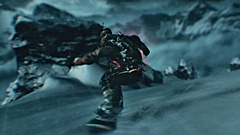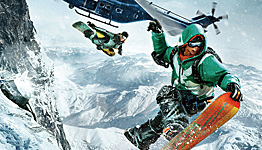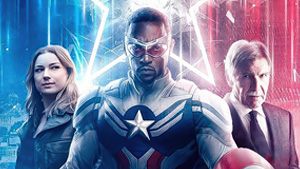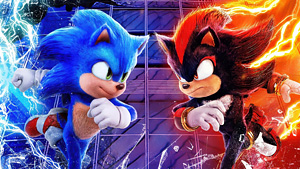March 3, 2012 by Paul Curtin


Premiering as a launch title on the PlayStation 2 back in 2000, SSX was a surprising hit that helped promote the PS2’s superior graphics and kicked off Electronic Arts’ over-the-top series of BIG Sports games similar to Midway’s NBA Jam and NFL Blitz. Unfortunately, the non-realistic style of games died out, and it’s been years since we’ve seen another SSX. Cue 2010’s VGAs where SSX’s official comeback trailer was debuted under the name SSX: Deadly Descents to a mixed reaction as fans feared the series seemed to be straying too far off course and away from its tricky past to cater to the current more serious Call of Duty generation. Unfortunately, those fans would turn out to be somewhat right.
SSX’s “story” revolves around previous Snowboard Super Cross member Griff leaving the team in order to go out on his own and become the game’s cocky and arrogant villain. SSX was never about the story, and the idea of getting the band back together by playing as the original game’s lead, Elise, who must now take on previous fan-favorites in order to recruit them and unlock new abilities by conquering the world’s nine Deadly Descents, works for me.
The problem with the story is the way in which it’s told. SSX features absolutely stunning visuals, yet its story is comprised of a weird mix of average CGI scenes that introduce events and lame comic book strips to introduce characters that are barely animated with no voice-over work. The poorly produced story almost seems like the development team needed something quick to replace a previously more serious story after a slight shift in the game’s direction, and this is the best they could come up with in a short matter of time and didn’t even have time to add an ending so they just decided to show off concept art once you beat the game.

But honestly, who really cares about story when you’re playing a snowboarding game? It’s the gameplay that counts, and SSX starts off great by dropping you out of a helicopter in order to perform an innovative freefalling tutorial and show off its improved current-gen visuals and exciting new controls that allow controller joysticks to be used to execute more complex moves as well as the original controls for old school gamers. After finishing the tutorial and finally landing on the slopes, SSX instantly becomes as enjoyable as it ever was when racing down beautiful mountains and stringing together gravity-defying mid-air tricks and rail grinds to rack up massive bonuses.
Like previous games, points that are earned during a run go towards the ability to activate a Tricky meter and perform even bigger and better tricks and transform the already awesome soundtrack comprised of alt rock, electronic, and hip hop into a remixed dubstep version of Run-D.M.C.’s “It’s Tricky.” There’s even the ability to grind and swing off the helicopter you originally drop from at times during runs when it quickly flies in after you get enough air on big jumps – it’s pretty damn epic.
Sadly, SSX’s level of fun hits a quick 180 when the game begins to stray from its roots and introduces new map designs and other concepts that take away from the fun, by far the worst of which is the new map designs that have been taken by NASA satellites of real world locations. In theory, this sounds awesome. Who doesn’t want to snowboard on some of the world’s craziest locales mother nature could come up with all while performing some of the craziest tricks a game developer could come up with?

However, the idea of combining more realistic levels with unrealistic tricks falls flat and just doesn’t work. You’ll constantly be falling off narrow cliffs, running into rocks, and losing races against opponents who seem to never mess up. What’s worse is the real world locations have actually been modified to make them harder to ride with the goal of some events simply being to survive. Really? Just survive? Certain levels even consist of riding through pitch black underground tunnels with a tiny light strapped to your character’s head that only shines directly ahead, so whenever your character spins or flips over jumps you can’t see anything. Add in narrow paths, massive drop-offs, and huge jumps, and it makes for one of the worst racing experiences ever that will have you cautiously “racing” at night like a blind elderly person in an express lane. Honestly, how could any developer think these were a good ideas?
Like the new helmet light feature, the developers have also come up with a whole bunch of innovative ways to expand upon traditional gameplay in each of SSX’s 9 different locations that require upgradable slotted items to be bought from the in-game store with credits earned from runs or actual real money via micro transactions (for shame, EA). You can equip purchases like a wingsuit that allows large gaps to be flown over, an oxygen tank to keep the character conscious on high altitude slopes, a solar suit that helps keep the player from freezing when in the shade, and tons of more cool features. Each new feature sounds great in theory, but it requires a change in the way the original games were played and leads to many, many rage-inducing moments — especially when racing against the final boss in a level that combines just about every annoying new concept. Innovation is awesome, and I’m all for developers changing things up to try something new, but when that change requires players to focus more on keeping their character from passing out before reaching the finish line than having fun and performing big tricks, it kills the innocent and enjoyable foundation that the SSX series was built on.
To try and compensate for the increased level of difficulty and poor level design, there’s even a new rewind feature that allows players to turn back time if a trick is botched or if they fall off a cliff. Again, sounds like a great idea and it works well for trick competitions, but when used in races where the time you rewind only affects you, it’s almost entirely pointless and would make more sense to just have a traditional automatic quick respawn and reset system. A lot of times you can even accidentally not rewind far enough back to where you’re a good ten to twenty feet away from the cliff you just fell off, but the momentum will still take you back over the cliff no matter how hard you steer away, resulting in multiple epic fails as your opponents just burst ahead, leaving you far behind.

If you want to race against friends locally, you can’t, there’s no splitscreen option. If you get tired of competing against computer opponents, you can switch to the new Global Events mode… and compete against ghost versions of players in real time who have previously hit the slopes. Yay? The nontraditional multiplayer mode doesn’t actually allow players to compete head to head against each other in the same game and instead uses a constantly updating leaderboard that rewards top players with credits from a prize pot for beating other players’ scores in challenges. It’s a unique way of doing multiplayer that some might like because it allows for competing against others even when they’re not online, but others might hate because it isn’t a true multiplayer competitive experience.
Featuring gravity defying tricks, returning characters, real world environments mapped by NASA satellites, and comic book-style scenes used to tell a “story”, the SSX series seems to be having a bit of an identity crisis. SSX’s solid controls and great visual animations stay true to the original game’s core that made the series what it is today; however, the weak multiplayer experience and even weaker singleplayer story do little to help justify the game’s comeback so soon, and new features and maps ultimately turn gameplay into a more complex and upsetting experience that ruins the mindless free-flowing fun we’ve all come to know and love. SSX games have always been about pulling off insane tricks and having fun, not playing as cautiously as possible in order to simply survive a run down a mountain. EA should have instead dropped SSX from the title and just called the game Deadly Descents. SSX gets 2.5 out of 5 stars (Okay).
The Pros
- Beautiful visuals with mesmerizing over-the-top trick animations
- Solid new controls that take advantage of controller joysticks
- Tricks are just as big and bad-ass as ever
- Great mix of music that makes descents enjoyable
The Cons
- More realistic level design features far too many obstacles to have fun
- Certain levels like the final race can be extremely rage-inducing
- New features are far better in theory than how they play out
- Story is comprised of lame and poorly produced comic strips
- Limited multiplayer doesn’t allow for head-to-head online battles











